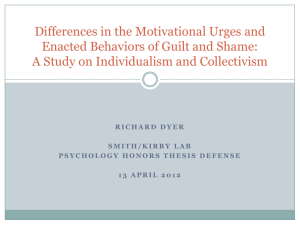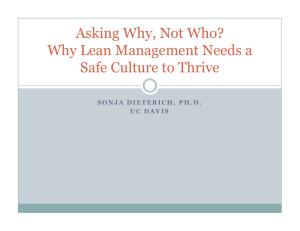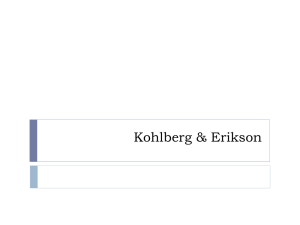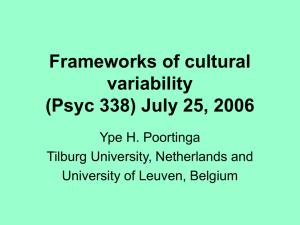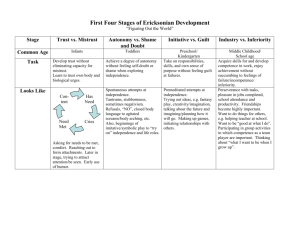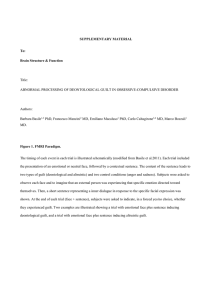PSY 2990 Honors Thesis Final
advertisement
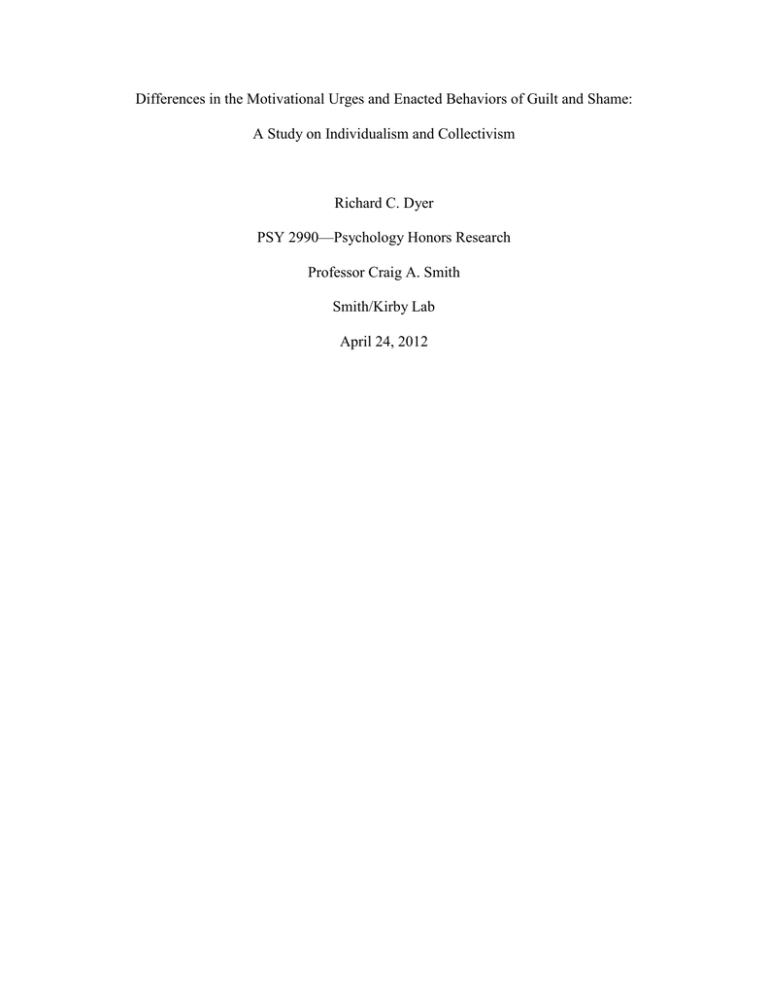
Differences in the Motivational Urges and Enacted Behaviors of Guilt and Shame: A Study on Individualism and Collectivism Richard C. Dyer PSY 2990—Psychology Honors Research Professor Craig A. Smith Smith/Kirby Lab April 24, 2012 Differences in the Motivational Urges and Enacted Behaviors of Guilt and Shame Dyer 1 Abstract There has been limited research regarding the differences in motivational urges, action tendencies and enacted behaviors on a cross-cultural basis. To study this, we administered an online questionnaire, composed of two parts. The first part of this study aimed to validate the EMGEBS scale (Smith & Kirby 2010) for a variety of negative emotions. The second part of this study looked at the relation between emotional correlations and action tendencies for guilt and shame. Further analysis was done to understand the unique action tendencies for each emotion, and whether or not individualism or collectivism (our proxy for cross-cultural differences) was a moderating factor. The statistical validation of the negative EMGEBS scale was successful. While the second part of the study yielded a number of unique action tendencies for guilt and shame, only two moderating effects were found for individualism and collectivism’s effect on the enacted behaviors. Differences in the Motivational Urges and Enacted Behaviors of Guilt and Shame Dyer 2 Introduction Emotions are complex to understand and take on an even greater degree of complexity when studied. Why does one situation elicit happiness in one person and sadness in another? What makes two very different situations elicit the same emotion in different people? How do the emotions you are experiencing in a situation influence how you behave in that situation? Attempting to answer these questions sheds some light on just how multifaceted and intricate emotions are. These questions are paramount to the study of emotions, specifically to appraisal theory. My area of interest lies within the cross-cultural differences in the motivational urges for and the actual behaviors elicited by the emotions, guilt and shame. Current research has answered many questions regarding cross-cultural psychology. However, components of appraisal theory, or “the claim that emotions are elicited by evaluations (appraisals) of events and situations” (Roseman & Smith, 2001), as well as issues, also covered by the theory, regarding the motivational urges and behaviors that the emotions themselves evoke, have only rarely been studied cross-culturally. Originally pioneered by psychologists Magda Arnold (1960) and Richard Lazarus (1982), appraisal theory looks to find answers to the questions posed above by evaluating individuals’ responses to situations, and what situations elicit certain emotions. The present research takes a look at individual differences in the motivational urges and actual actions associated with guilt and shame, through a proxy of individualism and collectivism for culture. Mauro (1992) researched differences in appraisal theory between three similar societies (People’s Republic of China, Hong Kong, and Japan) and the US, but found only significant differences on “complex dimensions” of emotional experience (control, responsibility, and norm/self-compatibility). On a broader basis, Scherer (1997) conducted a questionnaire study to Differences in the Motivational Urges and Enacted Behaviors of Guilt and Shame Dyer 3 look at the role of culture in emotional appraisal for seven different emotions. His study was a correlational study that retrospectively asked subjects to recall times in which they intensely felt the emotion asked for. Participants then answered questions about the severity of the feeling, events leading up to it, and their experience of the emotion. Interestingly enough, Scherer found that culture played the largest role in immorality, or what determines the morality of a situation or action. Culture, which was defined by a variety of “key variables” (such as Urbanism, Affluence, and Individualism) was constant for all participants in a specific country. Therefore, while both Mauro and Scherer’s studies provided a general background, Mauro’s study failed to look at the appraisals on an emotion basis. On the other hand, Scherer’s study failed to specifically target the differences in culture that are present within a country, but rather looked at the respondents from a singular country as a singular entity. This research aims to focus on a variety of emotions (specifically focusing on the analysis of shame and guilt) and empirically evaluate participants based on their individualism or collectivism ranking. In this research, we have decided to take a look at the action tendencies and enacted behaviors of individuals through the Emotivational Goals and Enacted Behavior Scale (EMGEBS) for both positive and negative emotions. First, to see whether or not the scales that we have developed in the lab are also accurate for negative emotions, we will investigate the reliability and validity of the action tendencies for guilt and shame. We will be using the motivational urges and enacted behaviors specifically in this study to see whether or not an individual’s specific behaviors are correlated with certain emotions. As we are looking at individualism and collectivism, we are specifically interested in whether and how an individual’s Differences in the Motivational Urges and Enacted Behaviors of Guilt and Shame Dyer 4 “cultural” orientation might influence how they are motivated to behave, and actually do behave, in response to certain emotions, specifically guilt and shame. Guilt, as loosely defined by Hoffman (1982), is “an emotional state produced by thoughts that we have not lived up to our ideal self and could have done otherwise”. Guilt is an interesting emotion due to its complexity. To feel guilt, an individual must have sufficiently cognitively developed to the point where they have “an ideal self” against which to compare their actual self. Whereas many psychologists agree that children become aware of when they have misbehaved or performed poorly in their second year (Kochanska, Gross, Lin, & Nichols, 2002), the full spectrum of guilt’s effects are not fully developed until after two years of age. In some senses, guilt is a motivating emotion as it inspires an individual to not fall short of his/her ideal self again. But, in other ways, it can be a debilitating emotion that further intensifies depression and negative feelings. Similar to other emotions in appraisal theory, guilty emotions in individuals are not always related to rational thoughts as guilt develops in both the absence and presence of rational thought. As Lazarus (1991) states both guilt and shame “are said to involve thoughts or actions that violate a social proscription that has been internalized”. He continues to differentiate between shame and guilt on the basis that guilt has to do with internalized values regarding right or wrong, and shame occurs because of differences between what a person is and what one wishes to be—their ego-identity. He continues on to say that shame truly can be an internalized ideal, as the social disapprover may be real or imagined. He also differentiates shame and guilt in terms of their action tendencies. For guilt, the “impulse seems to be to expiate, atone, or make reparation for the harm that has been done to another and perhaps seek punishment, all the more so when the harm to the other person is severe or unjustified”. On the other hand, Lazarus Differences in the Motivational Urges and Enacted Behaviors of Guilt and Shame Dyer 5 proposes that “the action tendency in shame, in contrast to guilt, is to hide, to avoid having one’s personal failure observed by anyone, especially someone who is personally important”. These ideas have been especially important in shaping the design of this study, and their possible crosscultural implications. As there has not been much research in the past on cross-cultural differences in guilt, this research will focus specifically on individual differences in the motivational urges and action tendencies for guilt and shame between individuals. Originally, the research was supposed to focus on cross-cultural research based off of location, but due to the time restrictions, it was not possible to recruit enough participants from areas outside of North America. Therefore, as a result, to try to test differences in Eastern and Western societies, we used individualistic and collectivist proxies in place of individuals from each location. In both Western and Eastern societies, there are different cultural norms that influence the appearance of these emotions in society. Historically, in Western-based, more individualistic societies, the culture emphasizes a “guilt-based” environment, while more traditional, collectivist societies (specifically Japan, Korea, etc.) are said to be “shame-based” (Benedict 1934; Lutz 1988). As a result of this, their specific opinions regarding guilt and shame are theorized to have become engrained into their culture. My research hopes to see whether or not a relationship exists specifically with the emotions being examined, guilt and shame. Similarly, Hoffman (1982) discusses guilt by dividing it into two segments: “Individual guilt is an inner reflection on personal wrongdoing, while collective guilt is a shared state resulting from group—such as corporate, national, or community—wrongdoing.” These differences in the manifestations of guilt show how individuals from different cultures, with different ranges of individualism and collectivism, Differences in the Motivational Urges and Enacted Behaviors of Guilt and Shame Dyer 6 might experience, and respond to guilt and shame differently. Therefore, I am looking to study the differences in the responses to these emotions, by identifying key differences in the motivational urges and actual behaviors that results from feeling these emotions. I have hypothesized that highly individualistic people are more likely to feel less motivational urges that have to do with social settings, such as “Vent”, and more likely to have urges to distance themselves from their social environment. Individualistic individuals’ motivational urges may be more likely to reduce the emotion felt. On the other hand, collectivist individuals are thought to credit society and the community when something positive occur, so therefore, we expected collectivist individuals to have motivational urges more likely to rectify their position in society, such as “make amends”. Similarly, we expected them to be less likely to have the desire to remove themselves from situations away from society, such as “Distance”. Previous research has left many gaps in knowledge about appraisal theory on a crosscultural basis. Scherer’s (1997) research was carried out over an 8-year period over 37 countries, a scale that cannot be replicated with this research. A large problem identified with this research was the lack of understanding and comprehension needed to prevent problems with language translation. As this study occurred in so many countries, it was not possible to truly explore the complexities of how each emotion is described within the language. The following research aims to avoid this problem through testing subjects only from English-based societies. By doing so, we aim to minimize differences resulting from language barriers. Future research that furthers this study must take this into account when translating these measures into other languages. To analyze the differences in individualism and collectivism, a scale was developed to empirically evaluate participants on separate individualism and collectivism dimensions. To Differences in the Motivational Urges and Enacted Behaviors of Guilt and Shame Dyer 7 study the perceived differences in culture, my research will employ two recently developed tests of individualism and collectivism. The first measure is the AICS (Auckland IndividualismCollectivism Scale), developed by Shulruf et. al’s (2007) study, in which they identified the three most important components for both individualism and collectivism. For individualism, they were independence, competitiveness, and uniqueness. For collectivism, they were advice, harmony, and closeness. Those who scored high on the individualistic scale were described as such: “Individualists are more likely to prioritize the self and be explicit in enhancing their selfesteem and consider themselves as unique compared to others. They are likely to belong to more in-groups in comparison to collectivists and are more likely to have a personal communication style that involves a direct communication style, including a higher likelihood of using I more than we”, more representative of a Western society. On the other hand, collectivists were described as such: “Collectivists identify themselves as members of a group to which they belong and are more likely to internalize the group’s goals and values and give these higher priority. The communication style of the collectivists is characterized by a tendency to use indirect language, quite often involving emotional restraint and the desire to keep harmony and save face within the group”. A table in Shulruf et. al’s study was used to correlate each question used in our survey to one of the components of individualism or collectivism. The components and questions were derived from a meta-analysis of research on the subject and a subsequent survey to determine how each question fit into the main components. The second measure incorporated to assess individualism was the West & Chen I/C Measure (West & Chen, 2008), which similarly looks at individualism and collectivism, based on three separate important components of each from research based off of China (collectivism) Differences in the Motivational Urges and Enacted Behaviors of Guilt and Shame Dyer 8 and the United States (individualism). For collectivism, these three components were “considering of one’s decisions on others, sharing of positive outcomes, and sharing of negative outcomes. For individualism, the three components were independence (e.g., ‘I don’t like to rely on other people.’), competitiveness (e.g., ‘I want to be the best every time I compete.’), and uniqueness (‘I am different from others.’)”. The data from this research supported this with a high correlation between individualistic tendencies (if an individual tended to be “independent”, they were also highly likely to be “unique” and “competitive”), while finding that collectivism may be more complex than the three dimensions described. For this reason, we will also employ the individualism rating from the West and Chen (2008) study to measure how individualistic an individual is. Based on the prior research, there are several hypotheses that we will test through this study. Some of the questions are outlined here: 1. First, we will test the statistical validity of the negative emotion EMGEBS and its subscales. This is further outlined in our methods section. 2. What specific action tendencies are associated with guilt and shame? Are they different, the same, or do they overlap? 3. Given these possibly unique motivational urges and action tendencies, is an individual’s individualism or collectivism predictive of certain behaviors for guilt and shame? 4. Are individuals’ motivational urges and action tendencies different? If so, do these differences correlate with high or low levels of individualism v. collectivism? These questions are what we explored and expounded upon in our research. Cross-culturally (based on our proxy of individualism and collectivism), we believe that guilt and shame will influence the motivational urges and enacted behaviors differently based upon an individual’s Differences in the Motivational Urges and Enacted Behaviors of Guilt and Shame Dyer 9 collectivism or individualism. We hypothesize that individualistic individuals will have motivational urges in line with their world view emphasizing “independence, competition, and uniqueness”, which would correlate to higher instances of motivational urges that distance themselves from their social environment, “Distance” or “Reduce the emotion felt”. On the other hand, we hypothesize that collectivist individuals’ motivational urges will moderate actions that are more community-based, such as “Talk with others” and “Behave pro-socially”. We hypothesize that the links between guilt and the enacted behavior will be more affected by individualism, while the links between shame and the enacted behavior will be more affected by collectivism. Differences in the Motivational Urges and Enacted Behaviors of Guilt and Shame Dyer 10 Method Participants The participants were 86 individuals (21 males and 65 females), of ages 18-43, almost all of which were college-age (18-23). They consisted of individuals from Vanderbilt University and a small minority also from Europe, South America and Asia (only English-speaking participants). The participants from Vanderbilt University were recruited through SONA, the university’s research website, and voluntarily signed up for the study. Participants received class credit for completing the online survey. The participants from outside of the SONA system were recruited in one of two ways. One group of participants was recruited through an email invitation to participate in the study by linking them to a URL. Another group was recruited through posting on a variety of psychology experiment boards where interested volunteers can go to participate in psychology studies of their choosing. Participants’ responses were kept anonymous. The majority of participants recruited in this manner were from North America. Procedure Participants were asked to complete a four-part within-person online questionnaire. The questionnaire first asked for basic demographic information, such as age, gender, location, and education status. Following this, the first part began when the participants were asked to recall a time that they felt one of eight emotions (happiness, gratitude, pride, challenge/determination, shame, guilt, anger, and resignation). This range of emotions was used to ensure variability in the types of experiences participants described in response to this survey. The emotion was randomly generated based on the last digit of a participants’ birth date. Participants were asked Differences in the Motivational Urges and Enacted Behaviors of Guilt and Shame Dyer 11 to describe in an open-ended fashion how they felt during this time solely focusing on this one event and the emotions felt, to have the participant truly focus on this event and its repercussions. The questionnaire then asked participants a series of questions to understand their appraisal of the situation, or how the situation was going to affect them in the future. Following this, the participants were asked to rate, for each of the 32 emotion ranges (see measure description below), the degree to which they had felt that emotion on a 100-point slider scale, with the two extremes “not at all” and “extremely”. The participants were then asked to rate, for each of 146 actions (see the description of the EMGEBS below) how much they wanted to perform each action while they were in the original experience, on a scale ranging from “not at all motivated to do this” to “extremely motivated to do this”. Finally, to conclude the description of the experience, participants were then asked the exact same series of questions, but instead, they were asked to indicate how they actually acted in the original situation they had described. This was rated from “did not do this at all” to “did this extremely much”. Finally, they were then presented with statements to evaluate their degree of individualism or collectivism (AICS and the West & Chen I/C Measure). The participants were then debriefed, thanked, and in the case of those participants receiving SONA credit, compensated for their participation. The larger survey included a variety of measures, but only the ones included in this specific analysis, with a direct effect on the questions being asked are discussed in depth here. Measures Emotional Scale After individuals were asked to recount an emotional experience that they had, they were then asked to rate their feeling of a variety of emotions. They were presented with a group of Differences in the Motivational Urges and Enacted Behaviors of Guilt and Shame Dyer 12 adjectives to describe an emotion, and were asked to rate how much they felt each group of emotions on a 100-point slider scale, anchored at “not at all” and “extremely”. The emotions tested were as follows: - - - Guilty/Culpable - Relieved/Unburdened - Tranquil/Calm/Serene Proud/Triumphant Afraid/Frightened/Scared - Defeated/Resigned/Beaten Sad/Downhearted/Blue - - Ashamed/Disgraced Disgusted/Repulsed/Revolted Frustrated/Thwarted/Exasperated - Irritated/Annoyed Regretful/Remorseful/Sorry - Indebted/Obligated - Determined/Motivated/Persistent - - - Curious/Inquisitive Grateful/Appreciative/Thankful - Joyful/Happy/Glad - Interested/Engaged, - Eager/Enthused/Excited Mad/Angry/Irate - Embarrassed/Humiliated Hopeful/Optimistic - Disappointed/Let down - Bored/Detached/Uninterested - Amused Shy/Timid/Bashful - - - Surprised/Astonished Satisfied/Content Nervous/Anxious/Apprehensive - Compassionate/Empathetic Overwhelmed/Overloaded/Rattled - Awed/Wondrous/Amazing EMGEBS The EMGEBS (Emotivational Goals and Enacted Behavior Scale) was developed by Smith and Kirby (2010), to study the range of behaviors an emotion might elicit or motivate in an individual. To generate the items, the principal investigators of the lab and student research assistants tried to include all motivational possibilities that could occur. Participants were asked to rate the items, by the degree to which “they wanted, or felt motivated, to perform the behavior in the situation described”, and then by the degree “to which they had actually performed the Differences in the Motivational Urges and Enacted Behaviors of Guilt and Shame Dyer 13 behavior in the described situation” (Smith & Kirby, 2012). Examples of behaviors they were asked about include “find a source of stimulation” (boredom), “laugh it off” (embarrassment), “apologize” (guilt) and “redeem myself in the eyes of others” (shame). The 78 items were developed to fully cover the range of behaviors that could result from the experience of an emotion, although as discussed below the initial emphasis of this instrument was on positive emotions. In the EMGEBS study (Smith & Kirby, 2010), the study primarily focused on positive emotions. Our study will focus on both positive and negative emotions, but will be based on an expanded EMGEBS style of evaluating motivational urges and actual behaviors. The original subscale consisted of 78 separate items, while the expanded version included 146 items designed to capture action tendencies and emotions associated with both positive and negative emotions.. Smith and Kirby (2012) conducted a cluster analysis to separate the statements on the original EMGEBS into 16 different subscales which are listed as follows (with the number of specific items for each scale in parentheses): “Persevere” (5), “Take on a new challenge” (2), “Seek information” (6), “Clear one’s mind” (6), “Focus one’s attention” (6), “Be spiritual” (3), “Celebrate” (5), “Savor the moment” (6), “Show off” (7), “Relax” (5), “Be creative” (4), “Worry” (3), “Behave pro-socially” (8), “Reward oneself” (2), “Think about the situation” (4), and “Talk with others” (4). There are also two separate single-item scales: “Be alone” and “Compare myself to others who are worse off than me”, for a total of 18 subscales. The ratings for the EMGEBS are on a 7-point scale, from “not at all motivated to do this” (1) to “extremely motivated to do this”(7), with “somewhat motivated to do this” (4) the middle point. For the actual behaviors, the ratings are also on a 7-point scale, from “did not do this at all” (1) to “did this extremely much” (7), with “did this somewhat” (4) the middle point. Differences Differences in the Motivational Urges and Enacted Behaviors of Guilt and Shame Dyer 14 between motivational and actual appraisal scores were calculated, as were scores on solely motivational and actual appraisal scores. These were crossed with the individualism ratings given to find a correlation. In the present sample, the Alpha reliabilities of the subscales are as follows: Subscale Motivational Urge Enacted Behavior Persevere (N = 86) = 0.85 = 0.84 Take on a new challenge 0.68 0.68 Seek information 0.80 0.81 Clear one’s mind 0.81 0.75 Focus one’s attention 0.82 0.79 Be spiritual 0.85 0.88 Celebrate 0.94 0.78 Savor the moment 0.92 0.93 Show off 0.80 0.76 Relax 0.67 0.77 Be creative 0.68 0.65 Worry 0.84 0.78 Behave pro-socially 0.90 0.88 Reward oneself 0.74 0.82 Think about the situation 0.69 0.83 Talk with others 0.73 0.81 Along with the test of the old subscales’ reliabilities, the expanded EMGEBS included 10 new subscales, as follows: Subscales Motivational Urge Actual Behavior Aggress = 0.91 = 0.83 Distance 0.91 0.88 Rationalize 0.81 0.84 Differences in the Motivational Urges and Enacted Behaviors of Guilt and Shame Seek stimulation 0.62 0.79 Hide 0.75 0.33 Humor 0.54 0.77 Make amends 0.91 0.89 Quit 0.84 0.84 Seek comfort 0.78 0.75 Reduce the emotion 0.80 0.72 Dyer 15 Individualism/Collectivism Scales Two scales were used to develop the individualism and collectivism scales used in data analysis. The AICS (Auckland Individualism and Collectivism Scale) consisted of 30 statements to which the participants respond on a scale of “strongly disagree” (1) to “strongly agree” (5). Scores were attributed to the participants based on a calculation of their scores within specific components (Individualism: Responsibility, Competitiveness, and Uniqueness; Collectivism: Advice and Harmony). Responses to this questionnaire show that lower levels of reliability are expected for both individualism and collectivism. From our data, we got Alpha reliability scores that were lower than desired, individualism ( = 0.65) and collectivism ( = 0.54). The West & Chen Individualism/Collectivism Scale measure consisted of 38 statements to which the participants responded on a scale of “strongly disagree” (1) to “strongly agree” (5). Scores were attributed to the participants based on a calculation of their scores within their specific components (Individualism: Independence, Competitiveness, and Uniqueness; Collectivism: Considering the implications of one’s decision for others, Sharing positive outcomes, and Sharing negative outcomes). Similarly to the AICS, the reliability scores were lower than desired, but above our threshold for reliable data ( 0.70): individualism ( = 0.71) and collectivism ( = 0.77). Differences in the Motivational Urges and Enacted Behaviors of Guilt and Shame Dyer 16 Due to high correlations between both the individualistic and collectivist subscales of the measures, the two subscales were combined to form a more reliable scale for individualism and collectivism in analysis. The combined individualism subscale had a nice reliability ( = 0.82), while the combined collectivism subscale was fairly reliable ( = 0.75). An analysis of the correlation between the combined subscales shows a high correlation between the combined individualistic scale and the baselines AICS (r = 0.92) and West & Chen (r = 0.91). For the combined collectivist scale, the combined measure shows a high correlation with the West & Chen scale (r = 0.91), but a lower correlation with the AICS scale (r = 0.59). The measures were combined for statistical analysis to stay consistent throughout. Differences in the Motivational Urges and Enacted Behaviors of Guilt and Shame Dyer 17 Results The results section will be composed of two parts: the first to examine both the motivational urges and action tendencies associated with shame and guilt, and the second, to examine whether collectivism or individualism moderates the relations between shame and guilt and these action tendencies and behaviors. Furthermore, we examine whether or not there is a difference between motivational urges and the enacted behaviors. Action Tendencies/Emotional Correlations In this analysis, we estimated and tested correlations of the emotions guilt and shame with the specific subscales of the action tendencies, or what an individual had the urge to do. We first computed zero-order correlations on the data set and found a number of subscales that were both positively and negatively correlated. For both guilt and shame, the subscales that were positively correlated at levels of significance (p < 0.01) are as follows (guilt correlation, shame correlation): Subscale Guilt Correlation Shame Correlation Clear one’s mind r = 0.44** r = 0.64** Worry 0.42** 0.47** Distance 0.50** 0.71** Rationalize 0.52** 0.56** Hide 0.32* 0.58** Make amends 0.73** 0.72** Quit 0.39** 0.55** Seek comfort 0.35* 0.48** Reduce the emotion 0.43** 0.67** Be alone 0.30 0.43** Compare myself to those who 0.18 0.32* Differences in the Motivational Urges and Enacted Behaviors of Guilt and Shame Dyer 18 are worse off than me Celebrate -0.43** -0.49** Savor -0.38** -0.54** Reward self -0.41** -0.35** * (p < .01), ** (p < .001) Because of the overlap that exists between guilt and shame (r = 0.77), the correlation profiles of the action tendencies appear virtually identical. Furthermore, shame has unique correlations with “Be alone” and “Compare myself to others who are worse off than me”. Similar to the positively correlated subscales, the negatively correlated subscales of significance are the same for guilt and shame (guilt correlation, shame correlation): “Celebrate” (r = -0.43, r = -0.49), “Savor” (r = -0.38, r = -0.54), and “Reward self” (r = -0.41, r = -0.35). A negative correlation means that when an individual is feeling guilty or ashamed, he or she would also feel an urge to inhibit these actions. In subsequent analyses, we will focus solely on the positively correlated subscales, or in other words those action tendencies that appear to be positively motivated by either of these emotions. The similarities of the correlation profiles determined the future analysis path for our research, as we wanted to examine whether any of these action tendencies were more characteristic of shame than guilt, or vice-versa. These results on individual emotional action tendencies are as expected for shame and guilt. There is a great deal of overlap for the action tendencies of shame and guilt because of the similarities in how they are expressed. This data shows just how intricate the differences between shame and guilt are because at the first level of analysis, they seem to have similar action tendencies. Further analysis is necessary to separate the unique action tendencies for each emotion. Differences in the Motivational Urges and Enacted Behaviors of Guilt and Shame Dyer 19 To distinguish which action tendencies are uniquely correlated with each emotion, we conducted a partial correlation analysis, controlling for the variance attributable to shame when analyzing for guilt, and controlling for the variance attributable to guilt when analyzing for shame. This analysis gave us the action tendencies unique to each emotion. For guilt, the only unique action tendency was “Make amends” (Partial r = 0.54, p < .01), a tendency observed throughout the literature examining guilt and its properties (Hoffman 1982; Lazarus 1991). Shame, on the other hand, had the following unique action tendencies: “Clear one’s mind” (Partial r = 0.54, p < .01), “Aggress” (Partial r = 0.40, p < .01), “Distance” (Partial r = 0.64, p < .01), “Hide” (r = 0.52, p < .01), “Make amends” (r = 0.33, a much smaller correlation than what is seen for guilt, p < .01), and “Quit” (r = 0.45, p < .01). These results are fairly consistent with what was originally hypothesized, with a couple of exceptions. Due to the previous research that had been done on guilt, it was thought that guilt would have an action tendency to atone (Lazarus 1991), an action that would be similar to “make amends”. Building off of this information, our team hypothesized that individuals would be less likely to have motivational urges that require interacting with others for shame. This research solidifies the thought that an action tendency for guilt is to try to make up for what one did when feeling guilty. Interestingly, this is the only action tendency that is correlated solely with guilt. Our original hypotheses thought that based on the difference in the correlations seen between guilt and shame for “make amends” (r = 0.54 for guilt, and r = 0.33 for shame), we see that making amends is highly prevalent in the expression of guilt. On the other hand, shame has a variety of unique action tendencies. Unlike guilt, the action tendencies found from our data showcase more aspects of the desire to hide from society, to which one feels ashamed, as was seen in the literature review. The subscales that are unique Differences in the Motivational Urges and Enacted Behaviors of Guilt and Shame Dyer 20 for shame are much more related to assuaging one’s concerns over what occurred, to reducing one’s interaction with a perceived judgmental force (Lazarus 1991). The data collected also follow this prediction that shame’s action tendency is to remove oneself from scrutiny. An interesting result from this is that also “aggress” was found to be an action tendency unique to shame. This is not what was predicted as it was thought that shame would produce actions that distanced participants’ from perceived judgment, while the urge to “aggress” is an action that usually puts one in direct conflict with society. This result shows the intricacy and complexity of these emotions as some of the original hypotheses based on previous research were upheld, but also new information was gleaned about how guilt and shame differ. Collectivism/Individualism Action Tendency Interactions To further our analysis, we then tested whether either individualism or collectivism had an influence on the connection between emotions and action tendencies. This was done through a regression that tested for the prediction of the action tendency for a specific emotion. The regression was structured to predict the action tendency given the emotion (either guilt or shame), controlling for the companion emotion (the one not originally used). After this, we test for whether or not the relation between the emotion and action tendency is moderated by individualism or collectivism. Through the regression, we were able to see whether or not individualism or collectivism was moderating the action tendency for the emotions guilt and shame. Theoretically, an action tendency is supposed to be based on the specific emotion, and therefore, we were not expecting to see much variability between action tendency and enacted behavior. Differences in the Motivational Urges and Enacted Behaviors of Guilt and Shame Dyer 21 As expected, there was not much of a link between predicting action tendencies based on emotions from how individualistic or collectivist an individual is. The only significant result from this analysis was that of the predictive effect of individualism on guilt’s action tendency to “make amends”. The p-value (p = 0.06) is moderately significant, and based on the results of the regression, the equation predicts that for individuals who are more individualistic, the effect of guilt on the motivational urge to “make amends” is less. Contrary to our original hypotheses, when the analysis was done for collectivism, there was no effect of guilt on the motivational urge to “make amends”. This was not as predicted by the literature review as it was hypothesized that collectivist individuals would be more likely to “make amends” when they felt guilty, but rather it was that individualistic individuals were less likely to feel an urge to “make amends”. To do this analysis to understand the moderating factor of individualism and guilt on predicting the urge to “make amends”, we first enter shame as our control variable. This is to understand whether what we are predicting or not is distinct from shame, and unique to guilt. We then enter guilt, which should be significant if the aspect of guilt is linked to the action tendency. The final two steps of the regression test for whether or not individualism is linked to the action tendency, and then when a cross product of guilt and individualism is entered, if the resulting significance is high enough, then an interaction is observed. The equation is as follows to solve for the standardized Beta weight (): “Urge to make amends” = 2.528 (constant) + (0.395 * shame) + (1.03 * guilt) + (0.13 * individualism) + (-0.31* guilt * individualism) Dyer 22 Differences in the Motivational Urges and Enacted Behaviors of Guilt and Shame To understand the difference between high and low individualist individuals on moderating guilt, we set the “Shame” variable equal to “0” and solve for the Beta weight of guilt. High individualists: “Urge to make amends” = 2.528 + (0.395 * 0) + (1.03 * guilt) + (0.13 * 1) + (-0.31* guilt * 1) = 2.658 + (0.90 * guilt) Low individualists: “Urge to make amends” = 2.528 + (0.395 * 0) + (1.03 * guilt) + (0.13 * -1) + (-0.31* guilt * -1) = 2.398 + (1.34 * guilt) The difference in Beta weight shows the influence of individualism, as it is shown to have a more moderating effect. Furthermore, to solve for the urge to make amends, we solve for the representative (high and low) values of guilt and individualism. Because the variables that we are using are standardized (SD = 1), we can solve for the high value with a value of 1, and a low value at a value of -1. High/Low Value “Urge to make amends” = High Guilt and High = 2.528 + 0.395 * (0) + 1.03 * (1) + Individualism 0.13 * (1) + (-0.31) * (1)(1) High Guilt and Low = 2.528 + 0.395 * (0) + 1.03 * (1) + Individualism 0.13 * (-1) + (-0.31) * (1)(-1) Low Guilt and High = 2.528 + 0.395 * (0) + 1.03 * (-1) + Individualism 0.13 * (1) + (-0.31) * (-1)(1) Low Guilt and Low = 2.528 + 0.395 * (0) + 1.03 * (-1) + Predicted Scores 3.378 3.736 1.936 1.058 Differences in the Motivational Urges and Enacted Behaviors of Guilt and Shame Individualism Dyer 23 0.13 * (-1) + (-0.31) * (-1)(-1) The discrepancy in scores shows that individuals who are high on individualism have less of an influence by guilt on their motivational urges to “Make amends”. For the rest of the unique action tendencies for shame, only one significant result occurred. For the motivational urge “quit”, highly collectivist individuals were less likely to have a motivational urge to “quit” (p = 0.06). Similar to the analysis done for guilt, individualism, and “Make amends”, a similar analysis was done for shame, collectivism, and “Quit”. Unlike the analysis done on guilt, it was found that collectivism was linked to the action tendency “Quit”. No interaction with shame existed, but a trend was found that showed collectivism to be associated with less of a desire to quit. Besides this, none of the effects of subscales of the action tendencies were statistically significant. Further research is needed to understand how collectivism is related to the motivational urge to quit when feeling shameful. A final analysis was done to measure the interaction between motivational urges and action tendencies for behaviors. Of the analyses, only one significant moderation effect was found, that highly individualistic individuals are more likely to “hide” as an enacted behavior, despite similar levels in the action tendency stage. The rest of the moderation analyses were not significant. The correlations are as follows: Behavior Correlation between Motivational Urge and Action Tendencies Make amends r = 0.90 Clear one’s mind 0.93 Distance 0.72 Hide 0.78 Quit 0.64 Seek comfort 0.85 Differences in the Motivational Urges and Enacted Behaviors of Guilt and Shame Reduce one’s emotion Dyer 24 0.69 The correlations seen here are quite high, which could help explain the lack of influence of individualism and collectivism on the interaction of motivational urges and action tendencies. To further this analysis to check for moderation of actual behaviors from motivational urges, we tested for whether or not individualism or collectivism had an effect on the urge to do this behavior. All seven subscales were tested for the influence of both individualism and collectivism on the motivational urges’ tendency to act. Of the analyses, only one was found to be significant. This seems to both follow and diverge from the literature previously reviewed as highly collectivist individuals feel a greater sense of societal inclusion (Hoffman, 1982). Perhaps this explains why individualistic individuals are more likely to hide as they feel less of a sense of belonging in their societies. Differences in the Motivational Urges and Enacted Behaviors of Guilt and Shame Dyer 25 Discussion Although this research was unsuccessful in finding relationships among individualism, collectivism, and the motivational urges and enacted behaviors of the emotions guilt and shame, there are many important results that come from this study. We were able to successfully create behavioral subscales for negative emotions (EMGEBS) that were statistically validated through our data set. Further research on negative emotions, motivational urges, and enacted behaviors for these emotions can be conducted using the behavioral subscales created by our team. As predicted by Lazarus (1991), guilt’s unique action tendency was to “make amends”, something that was also seen in shame. But, unlike guilt, shame also exhibited six other unique action tendencies. These results show the inherent complexity of both guilt and shame, as we still do not fully understand the depth of feeling for each emotion. While the result of “making amends” is significant, we have not been able to isolate further action tendencies for guilt. We do know that guilt is a complex emotion, and although understanding the tendency to want to make amends is important, we would like to find further action tendencies that occur when an individual is feeling guilty. We would like to further our knowledge of an individual’s motivational urges to further understand the action tendencies beyond “making amends”. Shame, on the other hand, had a variety of action tendencies that were uniquely correlated (including “making amends”). Unlike guilt, shame yielded multiple correlated action tendencies. As a result, we are still looking at the multiple facets of shame, and more research is needed to further examine the motivational urges and action tendencies present when feeling ashamed. An interesting result of this study is that a unique action tendency for shame was to “aggress”. This is a conclusion that should be further examined to understand the relationship between shame and the urge to aggress. This result goes against what was originally thought Differences in the Motivational Urges and Enacted Behaviors of Guilt and Shame Dyer 26 about shame, as the motivational urges associated with shame were much more isolationist (Lazarus 1991). Many of the results from the second part of the study did not show a moderation of individualism or collectivism on the action tendency and enacted behavior. The limitations of this study, such as a small base of participants as well as a lack of geographic variety (the variable initially desired for use as a “proxy” for cultural differences), may have affected the lack of significant results. Due to the constraints of the study, many of the initial intentions were modified to work within these limitations. The initial goal of this study was to research crosscultural differences in the motivational urges and action tendencies for the emotions guilt and shame. Yet, due to logistical constraints, testing this on a purely cross-cultural basis was not possible. As proxies, scales of individualism and collectivism were used to differentiate between cultures. In future research, if possible, using the home location, as well as other cultural variables, of the participants would hopefully allow for a better comparison between cultures. Given that individualism and collectivism are only recently being studied on a psychological basis, our proxy of individualism and collectivism may not have been the most accurate in attempting to discern cultural differences between Western and Eastern societies. In the second part of the study, we determined that highly individualistic individuals have less of a motivational urge to “make amends” when feeling guilty. Also, highly collectivist individuals are less likely to actually “quit”, despite feeling the same motivational urge to quit. While there were not many significant results, both of these results are consistent with what is expected of individualistic and collectivistic individuals. A high level of individualism means less of a feeling of belonging and responsibility to the community of which one is a part. Therefore, as discussed while reviewing the literature, individual guilt has a higher prevalence in Differences in the Motivational Urges and Enacted Behaviors of Guilt and Shame Dyer 27 individualistic societies, and atoning or making amends has to do with a sense of community, a possible explanation for the lower levels of this motivational urge. Likewise, collectivist individuals are less likely to actually quit, which also makes sense as they have a stronger sense of responsibility to the community (Lutz, 1988). This research and future directions of this research have many implications for many cross-cultural areas of study outside of psychology. As anyone who consistently interacts with a different culture knows, it is important to understand the way that an individual’s background affects his or her actions. The implications of this research can be utilized in foreign relations, political science, international business, education of foreign students, and many other areas. Future research in this area should further focus on a variety of locations in order to have a larger range of cultural difference. Cross-cultural psychology focusing on emotion is a relatively new field, with a large potential for beneficial implications outside of psychology. The research presented here is an initial step into understanding the vast differences in culture and their effects on the actions associated with various emotional states. Limitations of Study As discussed previously, there are several limitations for this study. First, the usage of individualism/collectivism as a proxy for culture does not necessarily encompass all the complex differences inherent in culture. Individualism and collectivism have been studied for their relations to Western and Eastern cultures (where the majority of residents are English-speaking). While this was a step in the right direction, as it looks at more than just “country of residence” as a variable for culture, it still does not show the full spectrum of differences. The majority of Differences in the Motivational Urges and Enacted Behaviors of Guilt and Shame Dyer 28 participants came from societies considered “Western” or “Eastern”. The individualism and collectivism scales may not have been developed enough. Since individualism and collectivism have only been recently discussed on a psychological level, the lack of scales to measure components of individualism and collectivism could have made our results less accurate than desired. The specific reliabilities of the scales were not as high as desired when looked at separately, although a more reliable scale was determined through the combination of the AICS and West/Chen I/C Measure. A scale does not exist that results in an empirical value to measure the level of individualism/collectivism as a joint measure. While further research needs to be done to figure out if individualism and collectivism are truly on opposite spectrums, this may have made it harder to find a proxy for culture. Because of the logistical concerns of the study, the sample size desired was not able to be achieved. Not only was the lack of geographic variability a limitation, but there was also a heavily female-skewed response pool. A majority of participants were from Vanderbilt University, which had the effect of having a higher-income, highly educated participant base. The effect of these limitations is not known, but they are worth mentioning as these could have affected the results. Future Directions The field of cross-cultural psychology is only now fully being approached. As previous research has shown, there are many approaches to measuring cultural differences. In future research on the differences in motivational urges and enacted behaviors, it is important to fully establish a more complete way of determining cultural variety. As shown by Scherer (1997), Differences in the Motivational Urges and Enacted Behaviors of Guilt and Shame Dyer 29 using home location as the sole cultural factor leads to problems, but a combination of individualism/collectivism, location, and also factors such as affluence and urbanism (factors also looked at in the Scherer study) to find a way to truly measure the effect of culture on an individual, may more accurately parse out the defining features of cultural difference. Therefore, in order to fully understand cross-cultural differences, a standardized, reliable test for culture must exist, whatever the proxy, or lack thereof may be. The implications of this survey suggest that individualism and collectivism may not be the most important factor in understanding the differences between motivational urges and enacted behaviors. But, there were some interesting conclusions reached. In future research on this topic, it would be interesting to examine the factors that influenced results that differed from the original hypotheses. With a large sample base, we could further examine why “aggress” was a motivational urge present in shame, examining the causal factors behind it. Since it was found that individualism and collectivism do not have a moderating effect on this action tendency, it would be interesting to test the reasons behind this correlation with the action tendency. Another future direction that this research could take would be to look at the appraisals of certain emotions. To further understand the relationship between individualism and collectivism (with all the inherent limitations) and guilt and shame, it would be interesting to look at the appraisals of these emotions as well. While research exists documenting appraisals of both negative and positive emotions, it would be interesting to investigate the appraisals in conjunction with the motivational urges and enacted behaviors. Understanding the agency and whom an individual blames (especially for negative emotions as these are documented to have far-reaching negative repercussions) could be vital in understanding the relationship between these emotions and individualism and collectivism. Differences in the Motivational Urges and Enacted Behaviors of Guilt and Shame Dyer 30 Differences in the Motivational Urges and Enacted Behaviors of Guilt and Shame Dyer 31 Conclusion Emotions are complex entities. Culture is a concept that is still vaguely defined today. Understanding emotions on a cross-cultural basis proves even more confusing and difficult. Despite these difficulties, this research was able to develop a scale for the analysis of motivational urges and enacted behaviors for negative emotions (negative EMGEBS scale). Furthermore, specifically for the emotions guilt and shame, correlated action tendencies were found. Further analysis was done to understand the unique action tendencies of each emotion (Guilt: “Make amends”; Shame: “Clear one’s mind”, “Aggress”, “Distance”, “Hide”, “Make amends”, and “Quit”). Finally, the moderating effects of individualism and collectivism on the unique action tendencies were analyzed, with one significant result—for highly individualistic individuals, the influence of guilt on the urge to “Make amends” is less than individuals low on the individualistic scale. This research provides a base on which to build future studies on crosscultural emotional research. Differences in the Motivational Urges and Enacted Behaviors of Guilt and Shame Dyer 32 References Arnold, M. (1960). Emotion and personality. New York, NY: Columbia University Press. Bagby, R., Taylor, G., & Ryan, D. (1994). Toronto Alexithymia Scale: Relationship with personality and psychopathology measures. Psychotherapy and Psychosomatics, 45 (4), 207-215. Benedict, R. (1934). Patterns of culture. Boston, MA: Houghton Mifflin Co. Fiske, A. P., Kitayama, S., Markus, H. R., & Nisbett, R. E. (1998). The cultural matrix of social psychology. In D. Gilbert (4th Ed.), The handbook of social psychology, 915-981. Hoffman, M. L. (1982). Development of prosocial motivation: Empathy and guilt. In N. Eisenberg (Ed.), The development of prosocial behavior (218-231). New York, NY: Academic Press. Kochanska, G., Gross, J. N., Lin, M., & Nichols, K. E. (2002). Guilt in young children: Development, determinants, and relations with a broader system of standards. Child Development, 73(2), 461-482. Lazarus, R. (1982). Thoughts on the relations between emotion and cognition. American Psychologists, 31(9), 1019-1024. Lazarus, R. (1991). Emotion and adaptation. New York, NY: Oxford University Press. Lutz, C. (1987). Ethnographic perspectives on the emotion lexicon. In V. Hamilton et. al. (Eds.), Cognitive Perspectives on emotion and motivation (399-419). New York, NY: Kluwer Academic Publishers. Mauro, R., Sato, K., & Tucker, J. (1992). The role of appraisal in emotions: A cross-cultural study. Journal of Personality and Social Psychology, 62 (2), 301-317. Mesquita, B., & Walker, R. (2003). Cultural differences in emotions: A context for interpreting Differences in the Motivational Urges and Enacted Behaviors of Guilt and Shame Dyer 33 emotional experiences. Behaviour Research and Therapy, 41 (7), 777-793. Roseman, I. J., Smith, C. A., Scherer, K. R., Schorr, A., & Johnstone, T. (2001). Appraisal theory: Overview, assumptions, varieties, controversies. Appraisal Processes in Emotion: Theory, Methods. New York, NY: Oxford University Press. Salovey, P., Mayer, J., Goldman, S., Turvey, C., & Palfai, T. (1995). Emotional attention, clarity, and repair: Exploring emotional intelligence using the Trait Meta-Mood Scale. In J. Pennebaker (Ed.), Emotion, disclosure, and health (125-154). Washington DC: American Psychological Association. Scherer, K. R. (1997). The role of culture in emotion-antecedent appraisal. Journal of Personality and Social Psychology, 73 (5), 902-922. Shulruf, B., Hattie, J., & Dixon R. (2007). Development of a new measurement tool for individualism and collectivism. Journal of Psychoeducational Assessment, 25 (4), 385401. Smith, C. A., & Ellsworth, P. C. (1985). Patterns of cognitive appraisal in emotion. Journal of Personality and Social Psychology, 48 (4), 813-838. Smith C. A. & Kirby, L. D. (2010). Pleasure is complicated: On the differentiation of positive emotional experience. 11th Annual Meeting of the Society of Personality and Social Psychology (January). Las Vegas, NV. Smith, C. A., & Lazarus, R. S. (1990). Emotion and Adaptation. Handbook of personality: Theory and research. New York, NY: Guilford. Smith, C. A., & Lazarus, R. S. (1993). Appraisal components, core relational themes, and the emotions. Cognition and emotion, 7 (3/4), 233- 269. Swinkels, A. & Giuliano, T. A. (1995). The measurement and conceptualization of mood Differences in the Motivational Urges and Enacted Behaviors of Guilt and Shame Dyer 34 awareness: Monitoring and labeling one’s mood states. Personality and Social Psychology Bulletin, 21 (9), 934-949. West, S. G. & Chen, F. F. (2008). Measuring individualism and collectivism: The importance of considering differential components, reference groups, and measurement invariance. Journal of Research in Personality, 42, 259-294.
